
Logan and Albert Conservation Association

The Green Army and other crazy ideas
- first published in EcoNews from SCEC May-June 2013
Recent surveys in Australia and the US have found majority support for action on climate change. Clearly, even in these last bastions of climate denial, there is growing acknowledgement that we are facing a frightening future which will demand the employment of the best contemporary knowledge to come up with the most creative solutions, if we are to maintain our quality of life into the future.
But not the Federal Coalition. It is the conservative way to look back to the golden days of the past (and the Tea Party) for policy inspiration, and when you've backed yourself into a corner on carbon pricing with nowhere else to go, why not cobble up a crazy story and try to make it sound believable?
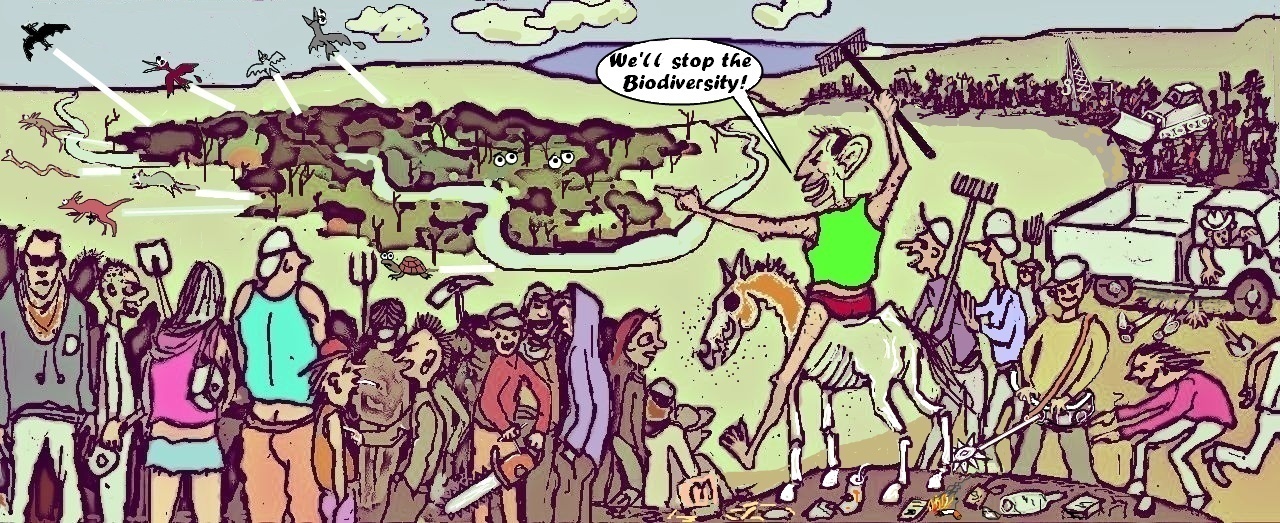
So what better for the Coalition than to reinvent the conservative ideology of 'work for the dole', combine it with Howard's Greencorps, dress it up as carbon reduction, and create a Green Army of 15000 to be recruited from somewhere within the ranks of the unemployed, disenchanted, and confused?
The Green Army is tasked with planting 20 million trees by 2020, and this has become a major plank in the Coalition's 'Direct Action' policy - a title with a swaggering, cut the crap, General McArthurish appeal to those voters who, the Coalition hopes, won't think too much about it. Furthermore, 'Direct Action' echoes notions embodied in the Coalition's 'delivering frontline services' mantra - in this case, doing the carbon abatement 'here, in Australia, where we benefit directly from it'.
All sounding fair enough?
Well, no. The science is becoming far less certain around a second key plank in the Coalition's Direct Action policy - soil carbon's value for carbon sequestration – and economists almost universally condemn a third plank - the competitive grant scheme (effectively a carbon tax in disguise) where the government will buy reverse auction emissions reductions bids from businesses - because it will result in enormous administrative loads and ballooning taxpayer costs.
As a result, the Coalition is finding that its Direct Action solution for carbon reduction is looking shakier than ever (although would-be deputy prime minister Barnaby Joyce still can't see anything wrong with it because it sounds good and... should work anyway, whatever).
To avoid looking too silly the Coalition has quickly advanced the Green Army forward as the flagship solution, particularly for its neat opportunities to create warm fuzzy propaganda about winning community hearts and minds and boot-camping 'lazy' youth, but especially because it will provide endless ministerial photo ops around 'mission accomplished' tree planting events.
If we do try to assume for a moment that the Coalition in Government will be genuine about using the Green Army to help achieve their commitment to a 5% carbon emissions target by 2020, then the deployment of this 'army' will have to be at the very least on the 'shock and awe' scale.
However, military jargon has always specialised in turning gore into glory. This will not be a disciplined army but a loose collection of 'militia', shanghaied for the job of planting 20 million trees by 2020, with a care factor somewhere around zero. And, if the Green Army is genuinely intended to meet its targets, it is the size, scale and speed needed to achieve its objectives that will create ugly problems.
At 15000 strong, the 'Green Army' will be larger than most state police forces, over half the size of the Australian army and similar to the air force and navy, without the supporting infrastructure that these bodies have. It will be composed of young, generally poorly committed novices, learning as they go, conscripted for just six mistake filled months before being replaced by new recruits - their tour of duty terminating just as they might be starting to 'get it'.
And this is one of the core problems. There is nothing wrong with planting lots of trees, but it has to be carried out with science and sympathy because ecosystems are very complex and enormous damage can be done through otherwise well-intentioned restoration schemes.
And the challenge is huge - according to their Direct Action Plan, the Coalition aims to offset 15 million tonnes of emissions by 2020 through tree planting. To achieve this it has been estimated that an area of 25,000 square kilometres will be required, plus about 9,100 GL of water - two and a half times that proposed for the Murray Darling Basin Plan.
So it will not be a trained and disciplined army which will face these impossible challenges, and the collateral damage is likely to be severe. Biodiversity will be the big loser, but also water quality and farming may be impacted, and communities and local councils will be obliged to pick up the pieces. Most pertinently, the objective of sequestering enough carbon to meet the 2020 five per cent carbon reduction target simply cannot be meaningfully assisted by planting 20 million trees in this way, within this time frame.
 At times we humans feel threatened by some of our native animals and call for government to protect us from these creatures we cannot control. What can we control? Animals that are vulnerable to our physical strength suffer many inhumanities - based on inherited practices. Since 2008 laws in Queensland have protected threatened flying-foxes from being shot and electrocuted, requiring farmers to use non-lethal methods, such as netting, to protect their crops. But the Liberal National Party have said that if elected they will overturn these laws. This backwards step in animal protection may once again mean flying-foxes can be shot and electrocuted, causing widespread suffering and further threatening this dwindling species' numbers. Katter's Australia Party have also made some worrying statements about animal welfare.
At times we humans feel threatened by some of our native animals and call for government to protect us from these creatures we cannot control. What can we control? Animals that are vulnerable to our physical strength suffer many inhumanities - based on inherited practices. Since 2008 laws in Queensland have protected threatened flying-foxes from being shot and electrocuted, requiring farmers to use non-lethal methods, such as netting, to protect their crops. But the Liberal National Party have said that if elected they will overturn these laws. This backwards step in animal protection may once again mean flying-foxes can be shot and electrocuted, causing widespread suffering and further threatening this dwindling species' numbers. Katter's Australia Party have also made some worrying statements about animal welfare.
Inhumane practices extend to our companion animals and livestock that provide food. Life in the fast lane has distanced us fron nature - its ambience and tranquility, its free ecosystems sevices such as clean air, clean water, pollination of plants for beauty and food. A life of convenience comfort and pleasure - bought as cheaply as possible - is expected now by many.
2012 - the year of RIO+20 is a time for reflection of our values aspirations vision for the future - a sustainable future for both the human species and all other interdependant life. This global summit needs to matched at our own local and regional levels as we go about our daily lives - respecting and valuing all forms of life - biodiversity.
Admittedly some folk feel a colony of flying foxes may be noisy and somewhat messy, but others value the services provided - from pollinating our eucalypt trees to devouring thousands of small insects. We can not duplicate those services. Imagine an Australia without gum trees!
Fear of death from Hendra virus has been dramatised in the media and demonised the flying fox. In reality there are far greater hazards we contend with on a daily basis. In most instances managing our own human behaviours can reduce risks.
Our ever growing human population is placing a heavy burden on the world's resources. In Australia we have a species extinction rate which is embarrassing. Becoming well informed conscious consumers is everyone's responsibility. Learning to live lightly on the planet can only help to preserve its biodiversity.
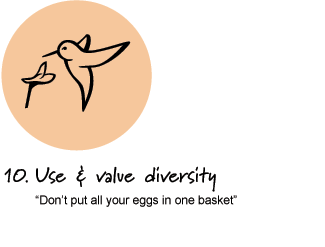 The Logan and Albert Conservation Association (LACA) does not support the use of critical ecosystems and habitat, wetland areas or areas of biodiversity for transport infrastructure corridors.
The Logan and Albert Conservation Association (LACA) does not support the use of critical ecosystems and habitat, wetland areas or areas of biodiversity for transport infrastructure corridors.
LACA does not support the degradation or loss of habitat, wetlands, biodiversity, or ecological corridors. For these reasons, LACA does not support any road corridor or any other infrastructure corridor that would degrade and remove the biodiversity, habitat or ecosystem functions and services for the area between the Logan Motorway and the Logan River.
LACA recognizes the value of protecting critical habitats, ecosystems, wetlands, riparian areas and biodiversity assets such as those at Karawatha Forest, Berrinba, 'Rosicrucian' land, Scrubby Creek, habitat that remains south of the Logan Motorway, Jerry's Downfall Reserve, Chambers Creek and the Logan River and its tributaries.
Calculation of the potential future carbon footrprint and offset now and in the future and providing this information to the community for accountability is essential to evaluate viability.
Investment in developing a SUSTAINABLE TRANSPORT PLAN which will reduce need to construct any further roads for motor vehicles including public transport options, comprehensive bicycle / motorized scooters/wheelchair lanes and independent mobility devices for disabled should be considered as a viable alternative to new motorways.
Globally many countries are applying The Economics of Ecosystems and Biodiversity [TEEB] PRINCIPLES to account for real cost of exploitation of natural environment for built infrastructure. These reports are available at www.teebweb.org. Our local and state governments would find these useful tools for evaluating loss of biodiversity and ecosystem services.
As a member of the CSRG LACA submitted OUR ENVIRONMENTAL VALUES. See them here. environmental_values_LACA_PARK_RIDGE_CONNECTOR_ROAD.pdf 142.99 Kb 05/11/2011, 12:54
environmental_values_LACA_PARK_RIDGE_CONNECTOR_ROAD.pdf 142.99 Kb 05/11/2011, 12:54
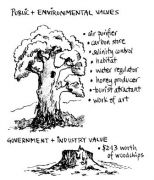 I speak for the trees for the trees have no tongues
I speak for the trees for the trees have no tongues
- The Lorax, Dr Seuss
Have you ever looked at trees and thought they just stand there and do nothing? It may seem that way, but in fact they are very busy doing a mixture of jobs that are really important.
What they are doing can be described as ecosystem services. Animal houses, air, rain and shade makers (If trees didn't breathe, neither could we. The health of our air, soil and water all relies on trees to keep it clean.) and even dead trees play an important role. Fallen trees provide shelter and food for many animals. See
http://www.acfonline.org.au/articles/news.asp?news_id=3459 to read more
KOALA data collection in Logan - can you help?
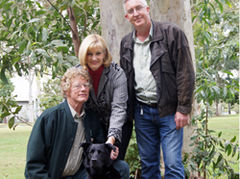 The announcement by Logan City Council that it will ask residents to collect information regarding the sex, health, location, behaviour and the tree species in which koalas are located is welcome. There is an acknowledgement that koalas are an important part of our environment.
The announcement by Logan City Council that it will ask residents to collect information regarding the sex, health, location, behaviour and the tree species in which koalas are located is welcome. There is an acknowledgement that koalas are an important part of our environment.
We are particularly keen to understand how Logan City Council's koala dog Oscar - pictured aside will complement the koala survey methods used by volunteer resident "citizen scientists" to provide more accurate local habitat mapping city wide.
Although curently Logan may be blessed by 78.9% tree cover that is subject to rapid clearing of sustantial areas for new housing developments, industrial development and the crisscrossing of roads creating a patchwork of disconnected areas of habitat which make no provisions for safe movement of any of our local fauna.
Read council's news re the koala dog here.
As yet there is no online process to become involved in the survey. Read about it here. Phone 3412 3412 for more information.
It is useful to understand that koalas' food source tree the eucalypt is eaten very selectively - only 17 out of 700 different gums are favoured locally growing gums - and then there are other factors not yet understood. In order for all plants to reproduce pollination has to occur and the pollinator of eucalypts is the flying fox.
Our much loved koala and the targeted maligned and misunderstood flying fox are co dependant - both needing the eucalypt as a food source. The flowers of gums open at night when flying foxes are foraging and are thus pollinated by these critically important animals. The collapse of honey bees worried our food production because the uncosted labour performed by bees is difficult to replicate by humans [ not impossible in some circumstances.
How would we scale trees at night in a 4 hour window of time to replace the pollination services of flying foxes? All too often we fail to see wider connections of ecosystem and ecological services - provided freely when biodiversity infrastructure is intact - by our ecosystem services.
 World Environment Day (WED) is an annual event that is aimed at being the biggest and most widely celebrated global day for positive environmental action. WED activities take place all year round but climax on 5 June every year, involving everyone from everywhere. India has been named Global Host of World Environment Day 2011. Each year focuses on a topic of global significance and asks that we look at what we can do to reduce human impact on that issue.
World Environment Day (WED) is an annual event that is aimed at being the biggest and most widely celebrated global day for positive environmental action. WED activities take place all year round but climax on 5 June every year, involving everyone from everywhere. India has been named Global Host of World Environment Day 2011. Each year focuses on a topic of global significance and asks that we look at what we can do to reduce human impact on that issue.
Forests cover one third of the earth's land mass, performing vital functions and services around the world which make our planet alive with possibilities. In fact, 1.6 billion people depend on forests for their livelihoods. They play a key role in our battle against climate change, releasing oxygen into the atmosphere while storing carbon dioxide. Read more about forests services here. Ecosystem services
See LEAF's Facebook page to contact coordinator -, add your comments and more.
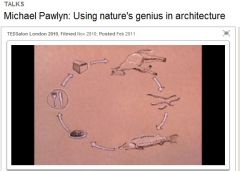 The human species has much to learn to live a truly sustainable life within the resources that are provided on the planet. All species have to breathe drink eat and have shelter. Nature has provided us with opportunities to model our lifestyles without destroying what we enjoy.
The human species has much to learn to live a truly sustainable life within the resources that are provided on the planet. All species have to breathe drink eat and have shelter. Nature has provided us with opportunities to model our lifestyles without destroying what we enjoy.
Who is listening and watching with an open mind?
Michael Pawlyn delivers his talk : Using nature's genius in architecture here.
There is no waste within nature's ecosysyem services. All products, species have a role to play in a closed loop system. Our throw away - out of sight - out of mind lifestyle is creating many challenging for the global and local human community to research and solve in creative innovative ways. Biomimicy - when we understand the process and system - potentially has answres for us.
Business as usual is not the solution. Rushing in and rebuilding and repeating errors and poor decisions from the past is not the solution.
Michael Pawlyn describes three habits of nature that could transform architecture and society: radical resource efficiency, closed loops, and drawing energy from the sun.
We know that there is a strong global trend towards urbanisation. Two hundred years ago the world's urban population was around 3 per cent. One hundred years ago, it was 14 per cent. According to a UN report (Global Environmental Outlook 2: Past, Present and Future Perspective, 2002), about half of the world's population now lives in urban areas; every week, over a million people leave their rural lives behind for the uncertain promise of the city.
Now more than half of the world's population live - or want to live - in an urban environment. And here in South East Queensland the state and some local councils are encouraging people to come - for a perceived economic prosperity.
Climate change and urbanisation are two major drivers of change in the 21st century. A third is the rapidly growing population - wth China being the only country with the politcal will to atempt to manage that growth. The ways in which these trends interact and how we respond to them will be of great consequence to the wellbeing of human populations and all life.
We can now say with considerable certainty that as the 21st century unfolds, climate change will have an increasing impact on the environment and human society worldwide. As much as we might like to avoid thinking about it, most prudent people now understand that we must plan and prepare for a carbon-constrained future.
There are plenty of reasons for concern.
Urban populations consume more energy and other resources and export more carbon and waste per person, causing disproportionate harm to natural ecosystems. In many cases, cities are particularly vulnerable to the effects of climate change such as rising sea levels, increased storm surges, and temperature extremes. Large cities create their own 'urban heat island' - the heat given off from the city itself can make it warmer than the surrounding countryside. The health of many other vital environmental resources, including forests, oceans, rivers, and wetlands, that provide essential ecosystem services - such as stormwater management, air purification, and reduced heating and cooling - are also in jeopardy.
However, there are also solid reasons for hope.
Cities facilitate the peaceful exchange of ideas that drive social and economic innovation. Urban communities provide concentrations of human talent to envision and redesign sustainable and resilient cities, and the financial and technical resources to support these changes. When viewed as nested systems, central cities, the greater metropolitan communities that surround them, and the natural bioregions in which they are located, may prove to be the most effective forms and levels of organisation for creating, testing, refining and replicating innovative and ecologically appropriate solutions.
Innovations that emerge from one urban community can be adapted by different communities in ways that reflect the opportunities and needs of their particular bioregions. Through this process the original idea may becomes stronger and more robust, encouraging the next cycle of innovation. To a large extent, we can choose whether our cities become ecological sinks that suck up the resources of the countryside, or ecological arks where humanity gathers to sort out how best to respond to climate change and other environmental challenges.
A number of cities around the world are already demonstrating impressive leadership as they seek to become more sustainable. They include Amsterdam, the Netherlands; Bogotá, Columbia; Copenhagen; Denmark; Curitiba, Brazil, Reykjavik, Iceland; and Vancouver, Canada. Several cities in the United States have also accepted the challenge of becoming sustainable cities.
Portland with a population slightly over 568,000, while the greater Portland-Vancouver metro area approached 2.2 million people has performed well in a competition to determine the 'greenest' or 'most sustainable' city in USA.
Some of the key sustainability features of Portland include:
An extensive light rail network, bio-diesel powered buses and an aerial tram as part of a multi-modal transit system;Close to 450km of on-street bike lanes, bike boulevards and paved trails - bike commuting has experienced three straight years of double-digit growth;
Neighbourhoods consciously-designed to be pedestrian-friendly; A strong commitment by Portland State University to research and implement sustainability practices;City Repair, an organisation that helps neighbourhoods move their plans through city bureaucracy, coordinates meetings, provides experienced natural designers and builders, and helps find materials and funds; Portland's watershed management plan, including: a proliferation of 'eco-roofs' on houses and buildings, featuring a waterproof membrane, drainage material, a layer of soil and a cover of plants; permeable streets and parking lots that allow rain to soak into the ground; rain gardens and green streets with curbside bioswales to remove silt and pollution from run-off; and The conversion of a waterfront freeway into a three kilometre 'greenway' park
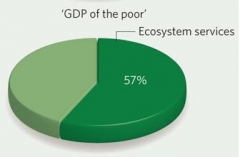
Pavan Sukhdev also has an article Costing the Earth available. He is study leader of the Economics of Ecosystems and Biodiversity (TEEB) project, United Nations
Clean air, fresh water, the flood protection provided by wetlands, the carbon-storage capacity of forests: these are examples of natural systems and processes that we largely take for granted. We consider them 'public goods': they are available to everyone; there is enough to go round; and one person's enjoyment of them does not impede another's. They are not traded in markets, not priced and they are mostly available for free.
Or you can search the archives here